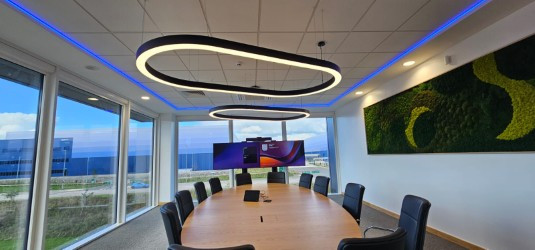Sonic construction – the potential to build with sound
The construction industry, for all its advancements in materials and machinery, still relies heavily on physical manipulation. The very act of building involves skilled workers and heavy equipment, but what if we could revolutionise this process? Let’s consider for the moment, the potential for a fascinating world of sonic construction, where sound waves could be used to manipulate and levitate materials, paving the way for a more precise, automated and even futuristic building experience, writes John Ridgeway.
The concept of acoustic levitation, the foundation for sonic construction, has its roots in the early 20th century. Pioneering physicist Paul Langevin first demonstrated the phenomenon in 1912, levitating small objects using sound waves. However, it wasn't until the latter half of the 20th century that advancements in acoustics and material science reignited interest in its practical applications.
In the 1960s, researchers began exploring the use of sound waves to manipulate and position molten metals during casting processes. This early exploration laid the groundwork for the potential use of sound in construction, where precise material movement is crucial.
How sound waves manipulate matter
Acoustic levitation relies on the principle that sound waves exert pressure on objects. By carefully controlling the frequency and intensity of these waves, researchers can create pressure zones that trap and manipulate small objects in mid-air.

This means we could use sound waves to precisely move and position building materials during assembly. This might be particularly useful for delicate or hazardous materials, or for tasks requiring high levels of precision. Sound waves could be used to guide prefabricated components into place during construction, or even manipulate individual bricks in a contactless 3D printing process.
There is also the possibility of self-assembly through sonic coding. By embedding specific sonic codes within building materials, researchers envision a future where components can self-assemble when exposed to the right sound waves. Consider components that click into place when exposed to a particular sound frequency, or prefabricated walls that automatically snap together when activated by sound.
The advantages of building with sound
Sound waves offer a highly precise and controllable way to manipulate materials. This could be especially beneficial for delicate or complex structures, where even slight misalignments can have significant consequences.
Since sound waves are contactless, this method could also be ideal for working with hazardous or sensitive materials. It also eliminates the need for physical manipulation tools, potentially reducing contamination risks in sterile environments.
Furthermore, the technology has the potential to be scalable, working with various material sizes and shapes. Additionally, the possibility of sonic coding for self-assembly opens doors for a high degree of automation in construction processes, with entire structures being built with minimal human intervention, significantly reducing construction times and costs.
However, while the potential of sonic construction is undeniable, several challenges would need to be addressed if it is ever to become mainstream. Generating and controlling the high-powered sound waves needed for levitation would be an energy-intensive process. Researchers would need to find efficient ways to use sound for this purpose, ensuring sustainable construction practices.
We also have to consider that not all materials will respond well to acoustic levitation, further limiting its use. The technology might be limited to specific materials with the right properties for sound manipulation. More research into material science and acoustic interaction is necessary in this area.
Sonic construction - the challenges
High-powered sound waves can also be dangerous. Ensuring worker safety and minimising sound exposure will be crucial for practical applications. This includes developing effective sound dampening technologies and implementing strict safety protocols during construction with sound.
Large-scale construction projects utilising sound waves are still very much a glimpse into the future, but researchers are actively exploring its potential. A research team at the National University of Singapore has successfully used acoustic levitation to manipulate molten metal droplets during 3D printing. This paves the way for the creation of complex 3D-printed structures with precise control over material placement.
Researchers at the École Polytechnique Fédérale de Lausanne (EPFL) in Switzerland have also demonstrated the use of sound waves to assemble microscopic components with high precision. This opens doors for the future of micro-manufacturing and the creation of intricate microfluidic devices used in medical diagnostics and lab-on-a-chip technologies.
While the field of sonic construction is still in its nascent stages, the potential for innovation is vast. We could see prefabricated building components embedded with microscopic sonic codes. Construction crews could use specialised sound emitters to activate these codes, triggering the self-assembly of walls, floors and even furniture. This could revolutionise construction in disaster zones or remote locations, allowing for rapid and automated building processes.
Sound-assisted 3D printing technology is already making strides in construction. By incorporating sonic levitation, 3D printers could manipulate a wider range of materials and create structures with intricate internal features. This could lead to the creation of stronger, lighter and more energy-efficient buildings.
Sound waves could also be potentially used to weld or join materials together without the need for traditional heat-based techniques. This could be particularly beneficial for joining dissimilar materials or creating ultra-strong bonds in critical structural components.
Without doubt, sonic construction has the potential to contribute to a more sustainable building industry. By minimising physical manipulation and potentially reducing the need for heavy machinery, the energy consumption associated with construction could be lowered. Additionally, the ability to create lighter and more energy-efficient structures could further contribute to a greener future.
For the moment it might seem like something out of science fiction, but the early research and potential benefits are undeniable. As we move forward, sonic construction has the potential to revolutionise the way we build, ushering in an era of precise, automated and sustainable construction practices. The future of construction might not be filled with the sounds of hammering and drilling, but rather the orchestrated symphony of carefully controlled sound waves, shaping the built environment with unprecedented precision and efficiency.
Additional Blogs

The changing face of workplace AV and what FM managers need to know
In today’s hybrid workplaces, facilities managers can no longer treat audio-visual systems as background infrastructure - they are now mission-critical assets that directly influence productivity,...
Read moreConstruction’s obsession with blame instead of learning
Construction is one of the most technically advanced industries in the built environment, yet culturally it often behaves like one of the least reflective. When things go wrong and they frequently...
Read more

How risk Is routinely pushed down the supply chain
Risk is an unavoidable part of construction. Every project involves uncertainty around ground conditions, weather, design coordination, procurement, labour and programme. Yet while risk is inherent,...
Read more